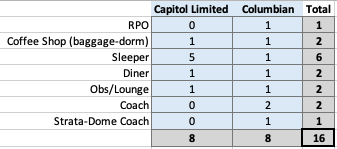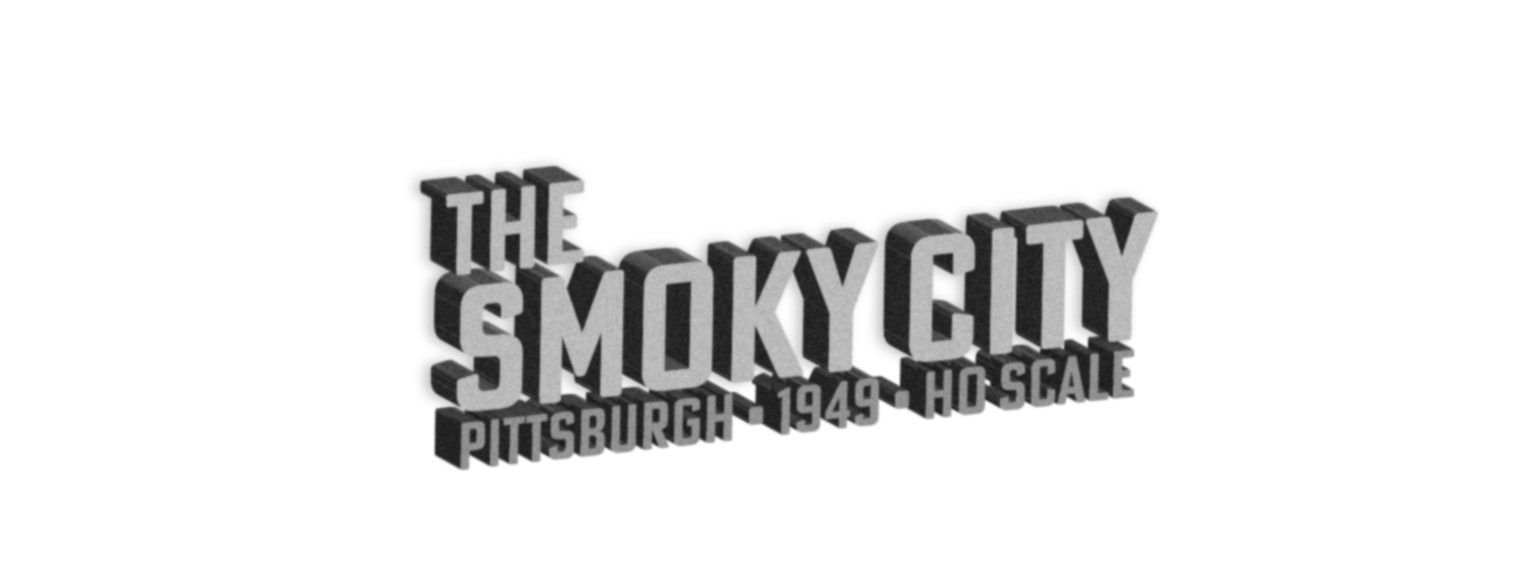In January of this year, I took my first steps toward building a roster (or at least the start of a plan for one). Using information in timetables from the B&O and P&LE, I compiled a spreadsheet listing the passenger and commuter trains using the P&LE terminal in 1949, including their scheduled times, direction, origination, destination and train numbers. With this information gathered in one place, I determined that the 40 daily arrivals and departures could be simulated with just 14 model trains, like actors playing multiple parts in a play. I was also able to identify how many storage tracks would be needed in the terminal scene and in the east and west staging yards, if all trains were to be modeled. I also decided to plan for two types of operating sessions: a day session for terminal arrivals and departures between 6:00 am and 5:30 pm and a night session for arrivals and departures between 8:30 pm and 4:00 am (there were no trains scheduled between 4 and 6 am). With a 3:1 fast clock, the 11.5-hour, 24-train day session would take about 4 hours, and the 7.5-hour, 16-train night session would take 2.5 hours.
Visualizing Train Movements
Knowing that the modeled portion of the railroad would end just one mile west of the terminal and 12 to the east, a look at the terminal schedule shows that the daily eastbound and westbound runs of each B&O and P&LE named train can be modeled by a single model train, using hidden return loops at each end of the layout. This should work fine for all but The Ambassador, which is scheduled to go through the terminal in each direction just four minutes apart. A schedule adjustment will probably be needed there.
To determine which un-named P&LE passenger trains could be doubled-up, I used slips of paper to represent each train (smaller slips to for commuter trains to differentiate from the longer passenger trains) and arranged them on the table in columns representing west staging, terminal, and east staging, depending on where each train would begin. The slips started out blank, and as I worked my way down the schedule to move the slip from one location to the next, I’d write the train number on the slip, and re-use them for later trains whenever possible. This showed that I could model all 12 commuter runs with just three sets of cars, and all 14 passenger trains could be modeled with 7 car sets. For the most part, all of these trains can be pulled by just two NYC/P&LE steam engines. Two Alco PAs are also needed to pull the Youngstown Express and Steel King, and an Erie Pacific alternates on the Steel King.
Storage Tracks
While determining how much I could consolidate train models, I also determined how many storage tracks would be needed for them in the staging and coach yards. During this process, each time a storage track was needed somewhere for an arrival or departure, a binder clip was placed on the table next to the slip. After running through a whole day’s schedule, I could see how many storage tracks I’d need in each location.
Identifying Car Types and Motive Power
The process of identifying the types of equipment running on the B&O through trains in 1949 began with a PDF copy of Through Passenger Train Consist Book No. 12, effective October 20, 1949, published by the B&O Transportation Department, which I purchased from the Baltimore and Ohio Railroad Historical Society. It lists all of the cars (coaches, sleepers, baggage, etc.) in each train, the cities where cars are added or removed, along with exceptions and other notes. The digital copy has a lot of hand-written notes and changes, and I’m not sure who made them or exactly what they mean, so I’m ignoring them in my planning.
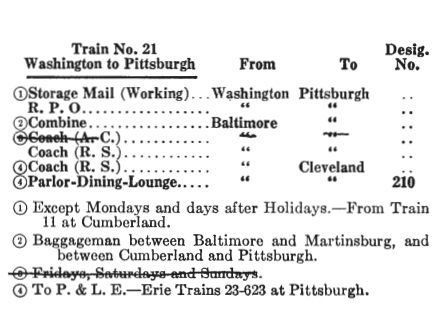
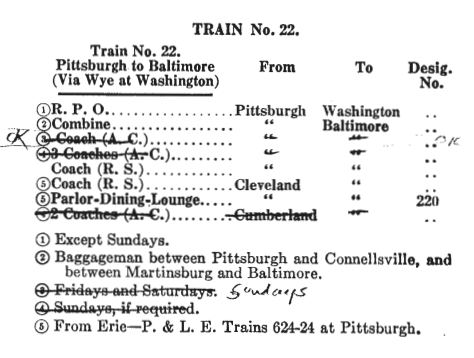
I entered the consist information for my seven routes of interest into a spreadsheet so that I can filter and sort it in different ways, to begin to understand what a model roster might consist of. The consist book provided a wealth of information I needed, but it doesn’t indicate which cars were heavyweight, streamlined heavyweight, or streamlined lightweight, nor what types of motive power were pulling them in 1949. I obtained that information from four other sources: First, Google searches, then an original copy of the B&O time tables effective 8/14/49 (couldn’t find a PDF online, so I bought this on eBay for $30), and then three books by Bob Withers: Baltimore & Ohio Through Passenger Service In Color, B&O Power In Color Volume 1: Steam & Cab Units, and Baltimore & Ohio Pacific Locomotives (available from the BORHS Company Store). The books are basically all photographs with a lot of information given in the captions, such as when equipment was purchased or retired, which trains are in the photos, dates, times, etc.
Locomotive List
Having all of the motive power information in my spreadsheet, and my terminal schedule on another spreadsheet, I was able identify all of the types of locomotives I’d still need to buy if I modeled the full passenger schedule and split it between the day and night sessions as described above. It was at this point in the process when I realized I can double-up on two B&O trains, since some of the day session equipment can be used on trains in the night session.
- 3 or 4 NYC/P&LE Alco S2 switchers
- 2 NYC/P&LE Pacifics
- 2 NYC/P&LE Alco PAs
- 1 Erie Heavy Pacific
- 2 B&O Light Pacifics
- 1 B&O E6 A/B pair
- 1 B&O EA/EB pair (or another E6 pair)
- 1 B&O F3 A/B pair
From that list, I’ve identified which models are currently available (new or used) and from which manufacturers, or suitable stand-ins. I already have two NYC/P&LE Mikados for freight service, but I haven’t put much thought into freight operations, other than identifying on-line industries. My interest is primarily in modeling passenger service, but I would like to include freight to some extent. This could be as one or two automated through freights running during a passenger operating session, or running local freight and switching moves outside of a structured session.
Passenger Car List
Once I figured out which trains were using heavyweight, streamlined heavyweight, and streamlined lightweight equipment, I was able to begin the process of eliminating cars from prototype consists, in order to form slightly shorter model consists. The use of different types of cars was simpler than I thought. Of the seven routes of interest, it seems only the Capitol Limited was using streamlined heavyweight equipment in 1949, only the Columbian was using streamlined lightweight equipment, and everything else was the older heavyweight equipment. As with the locomotives, most of the equipment for the two day session trains can be re-used in night session trains. That kind of consolidation requires purchasing fewer models, and less trackage in staging yards for storing idling equipment. It would require a little more switching between sessions, but I think the benefits would be worth it.
Heavyweight
Missing from the list of heavyweight equipment is the observation car, which I have one of from my dad’s old collection. By 1949, open platform observation cars had gone out of fashion (riding on them could be windy, loud and dusty), and they weren’t used on these seven trains. However, I think it’s plausible they’d still have seen occasional use as business cars at that time, by traveling B&O executives going to or through Pittsburgh, so my plan now is to detail the interior as a business car, and perhaps it too will see occasional use on these trains.
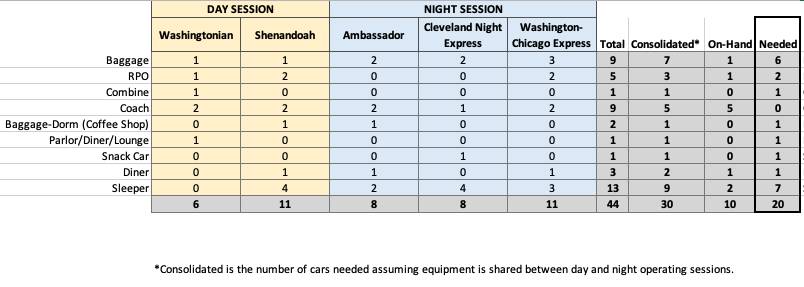
Streamlined
Since the Capitol Limited was using streamlined heavyweight equipment, and the Columbian was using streamlined lightweight equipment, there’s no potential for sharing equipment between these two trains. The one sleeper in the otherwise “all-coach” Columbian is only used on the westbound trip, and it’s added at Pittsburgh when it comes through at 11:25 pm. According to the time table, the sleeper opens for boarding at 9:00 PM.
